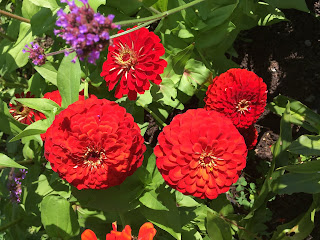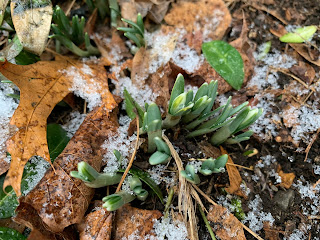 |
| There's room for a bed of cutting flowers in front of this fence |
This will be backsliding, because the flowers I’m thinking of including aren’t Northeast natives. Zinnias, dahlias, and globe amaranth (Gomphrena globosa) are all native to Central America. I’d also include celosias, from tropical areas in Africa and South America.
 |
| Zinnias make reliable cut flowers for me |
For cutting, I’m looking for flowers that last for several days after they’re picked. A couple of summers ago I tried subscribing for a flower share through our community supported agriculture. I found that the flowers didn’t last as long as blooms I picked at home, possibly because of stressful conditions during their trip from the field to the pick-up location.
 |
| Globe amaranth should work as a cutting flower |
Perhaps unsurprisingly, there’s lots of lore online from florists about how to extend vase life. Boiling it down, it seems that cut flowers need water to keep their tissues turgid, sugar to allow continued metabolism, and a germicide such as bleach to slow decomposition. Acidifying the water reportedly also helps; one source suggests adding citric acid-based soda such as 7-Up or Sprite for this purpose.
The farm and garden at University of California at Santa Cruz offers advice on the harvesting process, from cutting your flowers in the early morning when their tissues are full of water, to recognizing the right degree of flower opening, to when to plunge stems in warm versus cold water. They recommend flowers with thick stems and correspondingly thick xylem cells (water conductors) for longest life, fortunately including the dahlias I plan to enjoy.
 |
| Dahlias come in several elegant forms-photo Bernard Spragg |
To prepare the soil for this new use, I could start another sheet composting project. Over the summer, decomposition seems to have proceeded in the one I built last March from layers of wood chips and leaves sprinkled with compost. The level of the pile has sunk, and I’m expecting to be able to plant into it in spring 2021. I’d rather not wait two years to plant my cutting flowers, though.
Maybe I’ll just peel away the lawn grass and layer on some compost and composted cow manure. The resulting soil wouldn’t be as excellent as what I expect from the sheet compost approach, but it’d probably be good enough for the first year. Then next fall I could decide whether more thorough soil improvement is needed. I’ll surround the flower bed with wire fencing to keep my puppy from digging there.
Meanwhile, I’ve got lots of seeds ready to start. I sowed tiny celosia and globe amaranth seeds in six-packs this week to give them time to grow strong before moving to the new bed around May 15. I’ll start bigger seeds in March and April, shop for dahlia tubers, and hope for beautiful August bouquets.




















